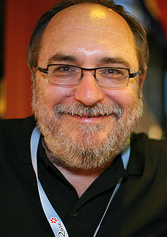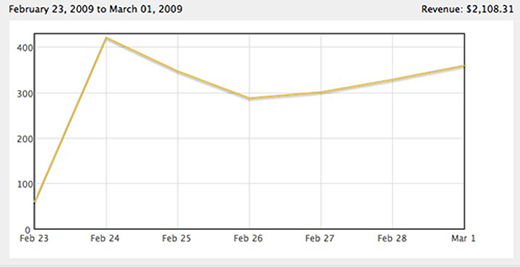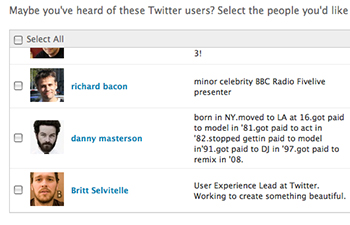There was a time when all you needed was a good record review in Rolling Stone or a stellar book review in the New York Times to get a boost in sales and popularity. But as those old gatekeepers lose their cachet in the digital age, a new set of gatekeepers has sprung up and they don’t have bylines. These are the editors who pick featured artists and apps at the Apple iTunes store, who choose videos to spotlight on YouTube, and who highlight Suggested Users on Twitter.
The most recent hubbub over the gatekeeping function started when Twitter began listing Suggested Users a couple months ago for newbies who weren’t following anyone and didn’t get how the service worked. By highlighting popular Twitter feeds from news organizations such as the New York Times and celebrities such as Britney Spears, Twitter hoped to hook new users. The problem? There was no explanation of how anyone made it onto such a list, and all the featured users started racking up huge numbers of followers.

Video host and blogger Veronica Belmont said her growth rate of followers shot up to a few thousand new ones per day — now hitting around 275,000.
“At the time that I was featured, I already had a pretty successful following on the site, at around 50,000 readers,” Belmont told me. “Maybe Twitter thought that if those people enjoyed my Tweets, then new people would as well. I tend to write about things in the technology world, but I intersperse it with funny or cool links I find throughout the day.”
Having a large audience of followers means that you could promote your personal blog, a book or another website — a marketer’s dream. Mahalo CEO Jason Calacanis made a kind of indecent proposal to Twitter, saying he would pay $500,000 to be a Suggested User for three years — equating it with a Super Bowl ad. Twitter didn’t bite.
“Of course, I was only half-bluffing with this move,” he wrote. “I was 90% sure Twitter wouldn’t take the money and I wouldn’t have to pony up a $250,000 check. However, if they did call my bluff and cashed in the $250K, I actually would have gotten what I wanted: two to ten million Twitter followers and the ability to drive one to two million visits to Mahalo a month from Twitter.”
Need for Transparency
Calacanis’ publicity move also brought the subject to a head among power Twitter users who felt slighted because they weren’t picked as Suggested Users. “Why them and not me?” was the overall feeling among many users, who envied having hundreds of thousands of followers.
Blogger and tech guru Dave Winer decided to start his own Twitter-like microblogging service, and was upset about the way Twitter went about picking Suggested Users.

“I do think the company should have done this much more carefully,” Winer wrote in a blog post titled Why It’s Time to Break Out of Twitter. “Now there’s no way to put the toothpaste back in the tube. And the people who got the push have a problem if they are members of the press, because this gift they got from Twitter is worth money. It might be worth a lot of money.”
NYU professor and PressThink blogger Jay Rosen did a couple podcasts with Winer talking about the power that Twitter now wields in choosing who will get the firehose of new followers from the Suggested Users page. Rosen told me that we need intelligent filters online, and when it comes down to human judgment, it should be clear who’s making the call.
“I would rather each company work out the best way to explain the grounds for its judgment where editorial powers (of a kind) are being exercised, and also show us how they educate — or leaven — their own judgment, interactively, by filtering demands from users but also making demands on users,” he said. “Leaving the blinds drawn, gradually growing into opaque institutions are not good options.”
Twitter co-founder Biz Stone told me that the Suggested User list was a stopgap measure that would likely morph into a more automated suggestion list that’s based on likes and dislikes.
“The way we see it now is similar to staff picks at your local book store but with accounts that could have a wider appeal,” Stone said via email. “In the future we’d like to make this smarter and take the editorial aspect out in favor of a more programmatic method for displaying the most relevant suggestions. For now this is having the desired effect of helping new users enjoy a more relevant experience.”

When I noted that some people were upset by the arbitrary nature of who was featured — including people who work at Twitter — Stone promised that he will try to be more open about the way feeds are featured.
[See UPDATE below with more from Stone.]
Apple’s Backroom Editorial Function
Meanwhile, Apple has become a force for digital music sales with its iTunes store, which now has films, TV shows, podcasts and apps. In each section of the store, there are featured slots for content and no explanations for how content gets featured. When I first wrote about this subject more than three years ago, Apple chief Steve Jobs had just sold his movie studio Pixar to Disney and I noticed that Disney content was being featured on iTunes.
In the past three years, iTunes has become an even more powerful force in digital content, and its featured picks can do even more to help boost sales and popularity. A podcast from NZMac.com was featured on the New Zealand version of iTunes, which brought in about eight times the usual download traffic, according to site proprietor Philip Roy.

And when Mike Campbell had his House Hunter app featured on iTunes, his sales went up astronomically. Campbell explained in a blog post that his sales were $101.63 the week before being featured, and were up to $2108.31 the first week it was featured. In both cases, the content owner did nothing to get featured, didn’t contact Apple or know why they were featured.
An Apple spokesperson told me that all featured slots are made as editorial decisions by Apple, and are not sold to publishers who want the coveted slots. “You can’t pay to get those slots,” the spokesperson told me. “There’s no pay to play, those are all editorial decisions. Are those decisions influenced by popularity? I’m sure, but there’s no money exchanged for that.”
However, music industry sources say that you can build relationships with Apple editors, just as you can with radio music directors, retail outlets and others along the old music distribution chain. That means it’s difficult to tell what’s going on in backroom negotations, where the music business has been notorious for its payola scandals.
Bruce Houghton, a music booker who writes the Hypebot blog, recently got insight into how iTunes chooses featured music slots. One former indie label digital promoter told Houghton:
I promoted my releases to [Apple editors], often times highlighting special content and exclusives. Generally this ‘tit’ produced a ‘tat’ where my releases were considered for genre page, SOTW [“Song of the Week”], or spotlight treatment. Sometimes their picks of my content were my priorities, sometimes they were just good music…
With our highest profile releases, we had explicit conversations about what exactly would be delivered by supplying exclusives. But this didn’t occur often. Only once in four years did I have a release that Cupertino dictated the promotion level to the other stores. I assume the majors [major labels] have that type of conversation with the major-[Apple] editors every week.
The problem for Apple is that doing backroom deals for what gets featured — in exchange for exclusive rights to certain unreleased music — means that others can get shut out of the process. And the lack of transparency means that the public won’t trust the service and what its editors feature. One step Apple could take on the road to transparency is bringing the editors out into the light, giving them blogs to write where they can explain the process out in the open.
YouTube Lessens Editorial Power
In the past, video giant YouTube was also criticized for making home page picks for videos without explaining the process behind the picks. In late 2006, many users complained that CBS videos were getting preferential treatment because of a business deal with YouTube. YouTube and CBS denied that at the time.

But now, just as Twitter’s Stone says he would like Twitter to move away from doing editorial picks, YouTube has been de-emphasizing “Featured Videos” on the home page. What used to be a long list of featured videos is now a small box that lives alongside “Recommended Videos” (based on videos you’ve watched before), “Friend Activity” (what your friends watch) “Promoted Videos” (obviously paid slots) and many other features.
YouTube recently changed the names of some of these home page sections to try to clarify how they are picked. However, there are still some gray areas. They recently started “Spotlight Videos,” which will include videos the YouTube editors believe are the best, and they plan to take “a more thematic approach to showcasing some of the best videos our community and partners produce,” according to YouTube product marketing manager Curtis Lee in a recent blog post.
Lee explains the “Featured Videos” section this way:
Featured Videos will be primarily populated with videos from YouTube’s thousands of partners, but they might also include select user videos that are currently popular or that we have previously showcased in Spotlight Videos. We will automatically rotate these videos throughout the day to keep them fresh.
So are they partner videos or user videos, and if it’s a mix, how can we tell which is which?
Another YouTube editor told me that the editorial calendar at YouTube had become quite light lately. “The community on YouTube is really what drives videos up in popularity,” he told me. “As time goes on, we’ve been phasing out the editorial aspect of YouTube significantly.”
The problem for these new gatekeepers is that they are providing the old editorial functions, but there’s a key difference between the way they operate and the way that movie critics, music reviewers and video store clerks operate: They are making editorial decisions without telling us who they are, what they like and how they are making those decisions. Otherwise, we will be left to wonder, left to come up with our own conspiracy theories, and we will lose trust in these services.
What do you think? How can these sites do a better job of being transparent with picks? Should they rely more on “most-viewed” or “most-downloaded” charts intead of editorial picks? Share your thoughts in the comments below.
UPDATE: Twitter’s Biz Stone has written a blog post in response to my queries explaining in more detail how the Suggested Users are chosen:
Our Chief Scientist developed a program that scans active Twitter accounts for a bunch of key ingredients such as how much of the profile is filled out, certain indications that the account is interesting to others in some respects, and a few other signals.
This program then generates a list of potentially interesting Twitter accounts that myself and some product team folks here at Twitter take a look at for another set of criteria. For example, is the account a good introduction to Twittering for a new user? Does the person or organization running the account have a fairly wide or mainstream appeal? If they are a celebrity or business, have we confirmed it’s really them?
Finally, we’ll do a gut check internally with a couple folks before adding them to the Suggested Users list. The list continues to grow and change although only a subset of 20 accounts are randomly displayed as suggestions during the new user signup process. Twitter is not paid to include accounts in this list. The Suggested Users feature exists to do a job — it makes Twitter more relevant and valuable to users. All that being said, when we find out Oprah starts Twittering for real we may very well put her on the list.
This is a great start toward more transparency for the service.
Photo of Dave Winer by Scott Beale via Flickr. Photo of Biz Stone by Jennifer Woodard Maderazo.


I think Digg has it right with community promoted content.
Just my two cents (and I didn’t receive them from @kevinrose).
Great article – I am the developer who worked on the House Hunter app and I can certainly see why this issue is important.
From reading the iPhone developer blogs I can tell you that the notion of being featured on Apple’s iTunes front page is extremely valuable. There is a potential for a lot of power, abuse of power, in those editorial decisions.
Oof. I think this is much thornier that it appears at first glance. Obviously, there is a significant demand for non-crowdsourced recommendations. And if the service doesn’t provide them (actually, even if it does), a third party eventually will. And in a way that will put these services at the mercy of the third party’s ethics.
I think that people need to be careful about reading too much into popularity. A friend of mine, now a professor at Princeton, did some great research on manipulating social influence that should be required reading:
http://www.sciencemag.org/cgi/content/short/311/5762/854
In any case, I offer an alternative measure of Twitter influence that at least offers the hope of more utility than easily gamed follower counts. Here’s an explanation, as well as a link to a live implementation:
http://thenoisychannel.com/2009/01/13/a-twitter-analog-to-pagerank/
http://tunkrank.com/
Amazon sells placement. Wonder if that’s why Apple, and not Amazon, is mentioned in this story.
“An Apple spokesperson told me that all featured slots are made as editorial decisions by Apple, and are not sold to publishers who want the coveted slots. “You can’t pay to get those slots,” the spokesperson told me. “There’s no pay to play, those are all editorial decisions. Are those decisions influenced by popularity? I’m sure, but there’s no money exchanged for that.”
I agree, people should not read too much into what or who is made popular. A lot of modern popularity is made, not earned. This article makes the assumption that there is some kind of transparency about who gets written up in Rolling Stone.
So, there’s a new batch of tastemakers. Why the fuss? I think its a good alternative to the old batch, where, by the way, a fair amount of money changes hands to make a person of thing “popular”.
Marcus,
It’s true that there were likely backroom deals made to get reviews in magazines, but at least you knew who was writing the review, what their tastes are, who they like, etc. In this case, the new gatekeepers don’t tell you who the editors are *or* what goes on behind the scenes.
Now is an opportunity to improve on the previous methods for featuring content, instead of being more opaque about it.
The problem with aggregate sites like Digg is that as they get more popular they tend to get “gamed” more by professional users. This is a problem of Marketing creeping into social media. In the end though, marketing firms becoming too involved in social media will be pissing in the pot and large sites will gradually become discredited as they grow and become a more valuable marketing tool. Luckily new ones will always take their place.
User voted charts are useful. But I still enjoy sometimes discovering a hidden treasure cia a gatekeeper.
These services would go a long way towards transparency (as well as increasing the value and cred of their gatekeepers) by naming the editors and admitting that sometimes things are featured because they can pass along an exclusive or good deal.
That would beat systems like the music retails “pay for price and positioning” or the supermarkets’ “pay of an end cap”.
username:kiessesme
name: hassan mohmed ali wali
city : sudia arbia lshrqia
address:A jawwal international : 009663508433023
jawwal out site city : 03508433023
jawwal in site city : 0508433023